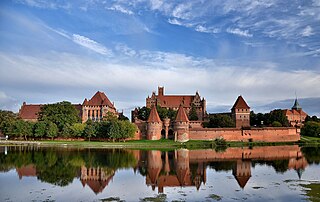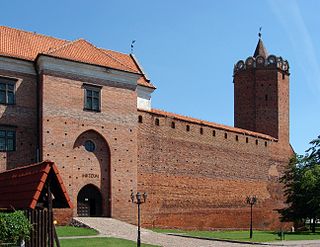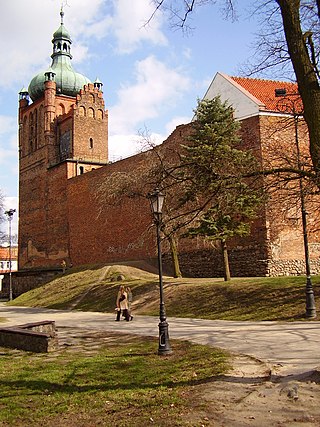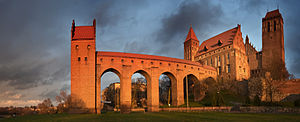
Kwidzyn is a town in northern Poland on the Liwa River. With a population of 37,975, it is the capital of Kwidzyn County in the Pomeranian Voivodeship.

The Royal Castle in Warsaw is a state museum and a national historical monument, which formerly served as the official royal residence of several Polish monarchs. The personal offices of the king and the administrative offices of the royal court were located in the Castle from the 16th century until the final partition of Poland in 1795. Situated in the Castle Square, at the entrance to the Old Town, the Royal Castle holds a significant collection of Polish and European art.

Gniew is a historic town situated on the left bank of the Vistula River, in the Pomeranian Voivodeship, in northern Poland. It has 6,870 inhabitants (2016). It is one of the oldest towns in Eastern Pomerania, and is renowned for its medieval brick gothic Castle, which has become one of the region's most recognizable monuments.

The Castle of the Teutonic Order in Malbork, commonly known as Malbork Castle, is a 13th-century castle complex located in the town of Malbork, Poland. It is the largest castle in the world measured by land area and a UNESCO World Heritage Site.

Krzyżtopór is a castle located in the village of Ujazd, Iwaniska commune, Opatów County, Świętokrzyskie Voivodeship, in southern Poland. It was originally built by a Polish nobleman and Voivode of Sandomierz, Krzysztof Ossoliński (1587–1645). The castle was partially destroyed during the Swedish invasion known as The Deluge in 1655, and then reduced to ruins during the war of the Bar Confederation by the Russians in 1770.

The Sandomierz Royal Castle is a medieval structure in Sandomierz, Poland. It was built on a slope of Vistula River by Casimir III the Great and extended in the 16th century. The original building was blown up in 1656, leaving only the west wing standing. It was later transformed into a Renaissance styled residence with the west wing preserved as a museum.

The Łęczyca Royal Castle is a medieval castle in Łęczyca, Poland, that was erected by Casimir III the Great as a fortification during 1357–1370.

Toruń Castle is a 13th- or 14th-century castle of the Teutonic Order located in Toruń, Poland. The castle is part of the Medieval Town of Toruń, one of the World Heritage Sites in Poland and Historic Monuments of Poland.

Bobrowniki Castle was built by the Teutonic Knights in the late fourteenth, early fifteenth centuries. Following the Peace of Thorn (1411), it was taken over by the Polish, later to become a residence of the local mayor. Since the eighteenth century the castle lies in ruins.

The Castle of the Masovian Dukes in Płock is a Gothic castle built under the reign of Casimir III the Great, becoming a stronghold of the Dukes of Masovia until the fifteenth century. The castle is located in the Princely Capital City of Płock, Masovian Voivodeship; in Poland.

The Lidzbark Castle, officially known as Lidzbark Bishops' Castle, is a fortified castle and palace from the 14th century located in the town of Lidzbark Warmiński, Warmian-Masurian Voivodeship, in northern Poland. It is one of the most precious Gothic structures in the country and a popular destination for holidaymakers.

Uniejów Castle - one of the main places of interest in Uniejów, Łódź Voivodeship; in Poland.

Gołuchów Castle is an early Renaissance castle built in 1550-1560 for Rafał Leszczyński on a square plan and used as a defensive stronghold and residence. The castle is located in Gołuchów, Greater Poland Voivodeship, Poland.

Reszel Castle is a castle located in Reszel by the bank of the river Sajna, in the south-east of the town.

Radzyń Chełmiński Castle is a Brick Gothic monastery-castle completed in 1330 as the seat of the Teutonic Knights' Commandry. It lies near Castle Lake to the north of the town of Radzyń Chełmiński. Three of the four walls and most of the internal buildings of the keep are ruined.

Teutonic Castle in Świecie is a partial ruin located in Świecie. The partial ruin is kept in full-shape from the bank of the river Vistula and Wda - together with a circular tower topped with merlons. The castle is part of a complex built by the Teutonic Knights in the Gothic architectural style. The castle was built on the site of a Pomeranian dukes' gord - located by the site of the castle. Formerly the castle had four corner towers, one of which survived. The castle is surrounded by a defensive wall and a moat. In 1410 the castle was looted by Polish forces obliterated the castle. The castle was owned by the Kingdom of Poland after the Second Peace of Thorn in 1466. In the sixteenth century, Castellan Konopacki reconstructed the castle into the Renaissance architectural style. The castle was devastated after the Deluge and since then was not rebuilt. The castle was furthermore devastated after Prussian forces used the castle as training grounds. Currently the castle houses a museum, with the tower and castle renovated.

The Olsztyn Castle, officially the Castle of Warmian Cathedral Chapter in Olsztyn, is a Brick Gothic castle located in the heart of Olsztyn, in northern Poland. Built in the 14th century, it served as the seat for administrators of property of the Warmian Cathedral Chapter. The most well-known administrator caretaker was Nicolaus Copernicus, a canon of Warmian Cathedral Chapter in Frombork, who resided here between 1516 and 1521. The largest expository room is the refectory with a diamond vault built around 1520. Currently, the castle houses the Museum of the Warmian-Masurian Voivodeship.

Bytów Castle is a Gothic Teutonic castle and a former stronghold for Pomeranian dukes located in the town of Bytów, Poland.

Lębork Castle - a castle built by the Teutonic Order located in Lębork, Pomeranian Voivodeship. The building is found on the river Łeba.

Ryn Castle is a fourteenth-century castle located between Ryn and Ołów Lake, by Liberty Square in Ryn, Poland.


























